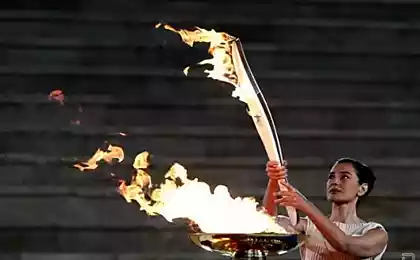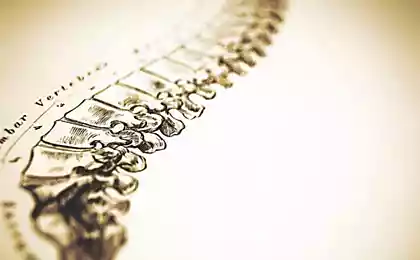455
Kinesio taping: Olympic method of pain relief sprains
Kinesio taping is a simple and effective method of treatment of sprains, muscle pain and other injuries, and hematomas and swelling, using a special adhesive tape (teip).
Developed by the Japanese reflexologist and chiropractor of Kenzo Casey for over 10 years used around the world, but in Russia became known recently. Summer Olympic games 2009 in Beijing became the debut of kinesio taping in the world of sport and the London Olympics 2012 the majority of athletes began to use this tool.

The essence of the method consists in the fact that to the affected area (the stretched muscle, tendon or hematoma) in a special way stick sticky stretchy tape (teip) with a length of several tens cm and a width of 5 cm – 10 cm There are several ways bonding tape depending on the effect we want to obtain. The tension of the tape very close to the tension of the human skin, so he kind of takes some of the load from worked plots, helping them in their work.
Effects of kinesio taping:
Numerous studies on athletes have shown that the effect of taping most pronounced during the first 5 days, after which the effect gradually decreases.The most significant effect – analgesic and anti-inflammatory. Just a few minutes after the proper bonding of the tape, the athlete feels pain relief and increased movement of the affected limb.

In contrast to the classical hard taping and elastic bandages, which are designed to ensure complete fixation, kinesio taping allows you to maintain mobility of the injured extremity. And not only to maintain but also to increase! This happens due to the fact that stretching the tape takes some of the load from tendons and muscles and lifts the skin and allows freedom of motion of liquids under it. Thus, kinesio taping allows the body to use its own strength to cure thanks to the support and stabilization of the muscles, joints and ligaments and increases the space for the circulation of intercellular fluid, blood and lymph.
Until recently, sports medicine has been the main and almost the only field of application of kinesio taping. But fortunately, the case is not in place and the methodology moving forward. In recent years, from sports kinesio taping went smoothly in General medicine due to its simplicity and efficiency.

Kinesio taping effective in the treatment of many diseases:
Particularly effective is the use of kinesio taping after an osteopathic session. In this case, the glued tape provides support and consolidate the effect achieved as a result of manipulation for 5 days,being "a continuation of the hands" of the osteopath.
As you know, the most important thing after an osteopathic session is to keep the achieved position of the tissues (bones, muscles, ligaments) so that they do not return to reverse the painful situation. In this and provides substantial assistance to the kinesio taping.
After 5 days of wearing duct tape fabric have time to memorize the new position and get used to it, and not go back to the disease. This allows to considerably facilitate the work of the osteopath, and the result is to reduce the number of sessions, to save time and (most importantly) money. published
Author: Igor Kutuzov
P. S. And remember, only by changing their consumption — together we change the world! ©
Source: doctorkutuzov.ru/ob-osteopatii/kineziotaping
Developed by the Japanese reflexologist and chiropractor of Kenzo Casey for over 10 years used around the world, but in Russia became known recently. Summer Olympic games 2009 in Beijing became the debut of kinesio taping in the world of sport and the London Olympics 2012 the majority of athletes began to use this tool.

The essence of the method consists in the fact that to the affected area (the stretched muscle, tendon or hematoma) in a special way stick sticky stretchy tape (teip) with a length of several tens cm and a width of 5 cm – 10 cm There are several ways bonding tape depending on the effect we want to obtain. The tension of the tape very close to the tension of the human skin, so he kind of takes some of the load from worked plots, helping them in their work.
Effects of kinesio taping:
- anesthetic;
- anti-inflammatory;
- relaxing effect on the muscles;
- resorption of edema and hematoma;
- lymphatic drainage;
- mild reduction of the joint;
- dynamic – facilitates movement of the limb or joint.
Numerous studies on athletes have shown that the effect of taping most pronounced during the first 5 days, after which the effect gradually decreases.The most significant effect – analgesic and anti-inflammatory. Just a few minutes after the proper bonding of the tape, the athlete feels pain relief and increased movement of the affected limb.

In contrast to the classical hard taping and elastic bandages, which are designed to ensure complete fixation, kinesio taping allows you to maintain mobility of the injured extremity. And not only to maintain but also to increase! This happens due to the fact that stretching the tape takes some of the load from tendons and muscles and lifts the skin and allows freedom of motion of liquids under it. Thus, kinesio taping allows the body to use its own strength to cure thanks to the support and stabilization of the muscles, joints and ligaments and increases the space for the circulation of intercellular fluid, blood and lymph.
Until recently, sports medicine has been the main and almost the only field of application of kinesio taping. But fortunately, the case is not in place and the methodology moving forward. In recent years, from sports kinesio taping went smoothly in General medicine due to its simplicity and efficiency.

Kinesio taping effective in the treatment of many diseases:
- sprain;
- soft tissue injuries and bruising;
- subluxation of the ankle, shoulder, fingers;
- scapulohumeral periarthritis (shoulder pain);
- tennis elbow and other tunnel syndromes;
- plantar fasciitis (heel spurs);
- knee pain;
- pain in the neck;
- headache;
- back pain, including pregnant women;
- osteochondrosis of the spine;
- lumbago;
- recovery after operation;
- painful periods;
- in Pediatrics, for violation of functional motor skills;
- and others.
Particularly effective is the use of kinesio taping after an osteopathic session. In this case, the glued tape provides support and consolidate the effect achieved as a result of manipulation for 5 days,being "a continuation of the hands" of the osteopath.
As you know, the most important thing after an osteopathic session is to keep the achieved position of the tissues (bones, muscles, ligaments) so that they do not return to reverse the painful situation. In this and provides substantial assistance to the kinesio taping.
After 5 days of wearing duct tape fabric have time to memorize the new position and get used to it, and not go back to the disease. This allows to considerably facilitate the work of the osteopath, and the result is to reduce the number of sessions, to save time and (most importantly) money. published
Author: Igor Kutuzov
P. S. And remember, only by changing their consumption — together we change the world! ©
Source: doctorkutuzov.ru/ob-osteopatii/kineziotaping























